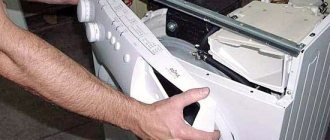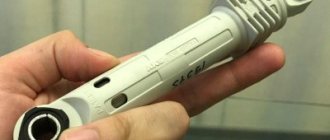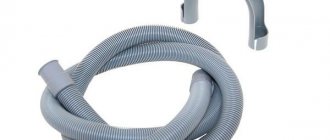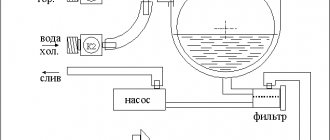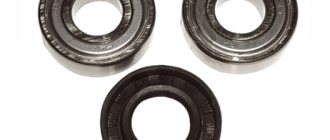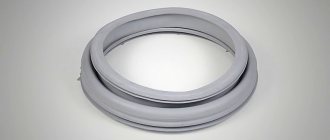Let's consider replacing the bearings of the Ariston AVL109 washing machine. Typical indications for repair are loud noise in the machine when spinning clothes, as well as play in the washing machine drum. This Ariston machine is made in Italy and has a stainless steel tank installed. On this model it is quite convenient to change bearings, but there are some nuances. A special feature of this Ariston washing machine is that the washing machine drum bearings are located in a metal cross located at the back of the tank, and to replace it you do not need to disassemble the entire tank, but just remove the cross. We will look at how to remove the cross of a washing machine and replace the bearings in this article.
Replacing bearings for an Ariston washing machine (Ariston)
Using the example discussed below, the bearings of an Ariston washing machine were replaced.
During operation, the rubber seal of the tank begins to let water through, which gets on the bearings, causing corrosion and accelerated wear. The average bearing life is 6–10 years. Before starting repairs, it is necessary to disconnect the washing machine from power and provide access to all its side surfaces. At the first stage, you need to empty the tank and remove it from the machine body. To do this, gain access to the inside by disconnecting the plastic plug located on the back wall of the machine, in the base area. Unscrew the tension screw of the clamp that secures the drain pipe to the tank. Disconnect the pipe from the tank.
Disconnect the motor power supply contacts. Remove the drive belt. The photo on the right (removing the belt) shows another washing machine, but the principle of removing the motor is also relevant for other models.
Unscrew, not completely, the two bolts securing the electric motor. Alternately, carefully apply pressure on one and the other bolts with the handle of a hammer to move the engine off the skids. After this, finally unscrew both bolts and, holding them, remove the engine.
Right there, at the bottom of the tank, there is a heating element. Disconnect the power contacts from it. Also disconnect all wires from the tank. Go to the top of the Ariston washing machine (Ariston). Unscrew the two screws securing the top cover from the rear wall. Slide the cover back and disconnect it from the body.
Pull out and remove the detergent dispenser. This will allow you to access the two control panel mounting screws that need to be removed.
Unscrew the second pair of mounting screws from the top (right and left). Detach the control panel, first from the dosing hopper, then the lower part.
The rubber cuff of the hatch (seal) is secured to the front wall of the washing machine using a metal wire clamp tightened by a spring. You need to find the tension spring by moving along the perimeter of the cuff edge. Use a flat object to pry the spring, gently pull it and remove it along with the clamp. Disconnect the cuff from the washing machine body. Disconnect the hatch lock by unscrewing the two fastening screws (pictured on the right).
Move to the bottom and detach the plinth panel from the front. We do this with a flat object, prying up the top edge of the panel. Now you have full access to the fastenings of the front wall of the Ariston washing machine. Unscrew two screws from the top (right and left) and several screws from the bottom.
Move it up a little and disconnect the front wall. Access is gained from the front to the inside of the machine. We unscrew the fastening bolts of the front, lower counterweight of the tank (in this example there are three bolts).
Disconnect and set aside the lower counterweight. We move on to the upper counterweight, unscrew the fastening bolts and carefully remove it from the seat of the plastic tank.
Unhook and remove the plastic clamp securing the rubber filler pipe to the tank. After this, it will be possible not to disconnect unnecessary elements, but to move the entire dispenser hopper to the rear wall and temporarily place it there.
Disconnect the level switch (pressostat) tube from the tank. Thus, only the suspension system (shock absorbers and springs) remains to be disconnected. We start with the shock absorbers, which are located at the bottom of the washing machine. The upper end they are attached to the tank, the lower end to the bottom of the machine. You need to disconnect the end of the shock absorber that is attached to the tank.
In this model, both ends of the shock absorber are secured with a plastic pin on the latch. One end of the pin is pointed, the other has a hole. In order to pull out the pin, you can use a self-tapping screw, which must be screwed into the hole of the pin as shown in the photo.
On the other hand, the plastic pin has a latch that prevents it from moving spontaneously while the washing machine is operating. You can tighten the latch using a spanner. Then, holding the key with one hand, with the other, using pliers, carefully pull out the pin, holding the screw.
Disconnect the shock absorber from the tank, moving it towards the side wall. Go to the top part, namely the suspension springs. Using a flat object (in the photo it is a slotted screwdriver), pry and disconnect the retainer for the upper fastening of both springs.
Check again whether all the elements are disconnected from the tank, after which it can be removed from the suspension springs and pulled out of the body of the Ariston washing machine. This must be done carefully so as not to damage the wiring and other elements of the machine that are located around the tank. To remove, the tank must be lifted up until the springs are completely loosened and disconnected. Then, carefully moving it outward, remove the tank and place it with the cuff down on the stands so as not to damage the plastic elements of the tank.
The second stage of repair to replace bearings is disassembling the plastic tank of the Ariston washing machine. You need to start by removing the drum pulley. To do this, you need to unscrew the fastening bolt, locking the pulley using the wooden handle of a hammer or other object. After this, remove the pulley from the shaft.
Sometimes this process is difficult, then you need to be patient and use your hands around the perimeter to pull the pulley toward you until it is completely removed from the shaft. Under the pulley there is a small part of the drum shaft and an outer bearing.
Place a wooden block on the shaft and use a hammer to knock the shaft out of the bearings. After this, you can begin to disconnect the two halves of the tank from each other. To do this, you need to unscrew all the screws securing the two halves around the perimeter of the tank.
After all the mounting screws have been removed, carefully insert a wide slotted screwdriver into the gap between the two halves of the tank and turn it around its axis in several different places. Once the gap between the halves has widened, use your hands to separate both halves.
One of the halves can be easily removed, but the drum needs to be removed from the other. If this cannot be done right away, then you need to once again attach the block to the drum shaft and additionally apply several blows with a hammer to the block until the drum separates from half of the tank.
After the drum is finally released, it is necessary to check the shaft and bushing (most often it is bronze) for damage. If the washing machine was operated for a long time with faulty bearings, they could partially or completely collapse and damage the shaft and bushing. If the shaft or bushing has strong grooves and chips, then the new bearings will not fit tightly on the shaft, and the oil seal will allow water to pass through, which will again lead to wear of the bearings.
Therefore, if the shaft and bushing are in good condition, then you need to thoroughly clean them of rust and deposits. When cleaning the shaft, you can use fine sandpaper. When cleaning the bushing, it is not recommended to use sandpaper; this may damage the oil seal. The bushing is cleaned with the finest abrasive sponge or other means to keep it absolutely smooth.
Also, when inspecting the drum, it is necessary to check the cross with which the shaft is attached to the drum. The silumin material from which the cross is made is sometimes destroyed by the aggressive environment in the tank. Then the rigidity of the shaft-drum attachment is broken, which leads to noise and vibration during spinning, and subsequently to the complete destruction of the washing unit.
In this example, the drum shaft with the cross is being replaced, since it is damaged (pictured in the center). The photo on the right shows half of the tank, into which the old bearings are pressed.
Old tank bearings must be knocked out using a metal rod (for example, a chisel) and a hammer. It’s more convenient to start with the outer bearing (pictured on the left). The chisel must be positioned as shown in the photo, while being careful not to damage the bearing mounting sockets. When striking, it is necessary to move in a circle so that the bearing does not warp. After removing the outer bearing, turn over half of the tank and knock out the inner one in the same way. The difference between the internal bearing is that the tank seal will also come out with it.
The photo on the right shows the new bearings, tank seal and drum cross with shaft.
Why do you need to change the bearing?
The average service life of a unit is from 6 to 10 years. After this time, the oil seal begins to lose elasticity, water from the tank gets onto the metal parts, washes away the lubricant, and the bearing becomes deformed.
Bearings can “knock” before their allotted time if, for example, you constantly overload the washing machine tank during washing. Factory defects in parts cannot be ruled out.
If you notice that there is a knocking and grinding sound when spinning the washing machine drum, this means that the bearings need to be changed urgently. Do not delay replacing parts - deformation of the oil seal and bearing can lead to breakage of the washing machine shaft and other expensive parts.
How to replace a bearing on an Ariston washing machine
Does your washing machine “jump” around the room during the spin cycle? Do strong vibrations, noise and hum interfere with your normal stay in the apartment? It is worth thinking about checking the equipment and its parts. Most often, the cause of such symptoms is wear and tear on the moving parts of the machine. In the article you will find information on how to replace the bearing on an Ariston washing machine and what disassembly sequence to follow.
Before starting repairs or replacing
Before you carry out repairs yourself and change the bearings, you need to carefully prepare a place where you can place all the parts of the machine so as not to lose anything, and after disassembling the Ariston washing machine with your own hands, you can easily assemble it in the required sequence.
It is recommended to fold parts in blocks, for example, put parts and elements adjacent to the top wall and control panel into one group, parts adjacent to the rear wall into the second group, and elements of the tank into the third.
It’s a good idea to have a clear plan for yourself and know in advance the sequence of disassembling the washing machine, and read repair tips from experts who share useful information online. You can also watch video clips on the topic and repeat all the steps exactly as a professional does.
Before you start repairing it yourself, it is important to disconnect the washing machine from the power system, as well as turn off the water supply and drain the liquid remaining after washing.
To do this, you need to disconnect a special plug, which, as a rule, is located in the lower right corner of the rear wall, remove the drain filter, and, placing a small vessel with low sides, drain the water into it.
It is also recommended to take photographs of the connection system of various equipment elements at various stages of disassembling the washing machine. This will help you later correctly assemble the washing machine after replacing the bearings, return all the components to their original position, and you won’t have to rack your brains about where to attach the remaining parts.
Step-by-step replacement instructions
Any equipment can be disassembled with your own hands according to a single scheme:
- The side panel is released, the screws are unscrewed using a screwdriver. Remove the support and release the pulley. Release the belt by removing the side panel.
- The locknut is unscrewed and the pulley is removed.
- The shaft grounding elements are removed.
- To consider the direction of unwinding, parts are cleaned with special paper, similar to sandpaper.
- The oil seal is released using calipers of different threads.
- The seals are treated with a special lubricant included in the kit.
- The new caliper is wrapped, attention is drawn to the arrow indicators. They show the sides of the twist.
- The bearing and oil seal are replaced in a similar way.
How many and where are the bearings in cars?
The silent operation of the new machine is ensured by two bearings (upper and lower), which are located behind the drum. Replacing these parts is a very labor-intensive process, since during the repair you will have to almost completely disassemble the washing machine.
The cost, time and complexity of replacing bearings directly depends on how quickly owners of household appliances notice signs of a problem and take measures to eliminate it.
Advice from the experts
Experts advise adhering to the following recommendations:
- Independent replacement is possible when the model of the machine is precisely determined and the necessary elements are selected for it. You also need tools for dismantling and replacing spare parts.
- Before disassembling the machine, you need to prepare the room. All unnecessary elements are removed, and space is freed up in the room for storing the removed elements.
- To avoid damaging the hatch, it is disassembled separately. First, disconnect the lock mechanism and its wiring. Then remove the hatch door, having first unscrewed the screws that hold its hinges. Only then do they remove the bolts and dismantle the necessary part of the body.
- It is easier to change flanges and bearings on a top-loading machine than on a horizontal-loading machine. The side panels are removed first, and only then the shaft of the smaller flange.
Replacing a bearing yourself does not seem difficult if you study the progress of the work in advance and thoroughly prepare for the process. Knowing the brand of the washing machine and having prepared the necessary tools for dismantling, you can easily carry out repairs.
Preparing the tool
Begin any job by preparing what may be required. For example, you may need a room or a spacious room in which it will be convenient to disassemble the car and store spare parts so that they can be easily found later. This is often the first problem on the way to repairing the washing machine yourself. Having disconnected the machine from all communications and placing it in a convenient place, we prepare the tool . May require:
- hammer;
- pliers
- flat and Phillips screwdrivers;
- metal rod;
- bearing puller;
- waterproof lubricant WD-40;
- sealant;
- open-end wrenches;
- marker.
In addition, new bearings and seals will be needed. If you know in advance what you need, you can buy them at the store. If not, then disassemble the machine and remove the faulty bearings, look at their markings and buy similar ones.
We disassemble the machine: we take out the tank
As you disassemble the washing machine step by step, you can take photos so that you can use them to put the equipment back together. Although this is not necessary, because in the video on this topic, everything is described in detail and has already been recorded.
So, we present the analysis of the Ariston front-facing machine in the form of the following algorithm:
- Unscrew the plastic cover located on the back wall of the case.
- Unscrew the bolts holding the top cover and remove it.
- We also remove the back wall of the case.
- Loosen the clamp on the pipe attached to the washing machine tank and remove the pipe.
- We take out the chip with wires from the electric motor.
- Remove the drive belt. In an Ariston machine, it is removed, as in many other washing machines; this process is described in detail in the article on how to change the drive belt in a washing machine - video.
- Loosen the 2 bolts holding the engine.
- Gently press on the bolts, holding the engine, then unscrew them completely and remove the engine from the car.
- Next, disconnect the power supply contacts from the heating element located under the tank.
- We check and disconnect all sensors.
- We move on to the front part of the case - take out the powder receptacle.
- Under the powder receiver we find the bolts holding the front panel and unscrew them.
- We unscrew 2 more bolts from the top, they also hold the control panel, and disconnect it.
- Remove the rubber cuff from the drum.
- We remove the bottom panel of the case and unscrew all the bolts that secure the front wall of the machine.
- Remove the front part of the housing.
- Unscrew and remove the counterweights.
- Disconnect the filler pipe from the tank.
- Remove the hose leading from the water level sensor to the tank.
- We remove the niche for the powder receptacle.
- Unscrew the shock absorbers.
- Using a flat-head screwdriver, remove the spring clamps on which the tank hangs.
- We make sure that everything is disconnected from the tank and take it out of the car.
Having pulled out the tank of the Ariston washing machine, you need to place it on the stands with the cuff down. Thus, half the way to get to the bearings has been completed. And that's not the hardest part.
Preparing for replacement
So, you are convinced that your washing machine needs to replace the bearing, and you are determined to do the work yourself without involving a technician. Where to begin?
First of all, you need to prepare a new set of bearings, including an oil seal. It is best to purchase original spare parts from the manufacturer, even if they cost more than their analogues. Replacing a bearing with your own hands is a labor-intensive process, so, you see, it is better to supply a high-quality part and not return to this issue again.
For repairs you will also need:
- flat and Phillips screwdrivers;
- chisel or impact screwdriver;
- hammer;
- pliers;
- wire cutters;
- puller (optional);
- socket wrenches;
- WD-40 product;
- glue;
- sealant.
The photo shows the tools and equipment necessary to replace the bearing.
Before disassembling the body of the washing machine, you need to make enough space both for work and for storing parts. Disconnect the unit from the power supply, disconnect the water supply and drainage hoses, move the equipment away from the wall so that it can be accessed from all sides.

